Florida has a unique landscape because of the many zones, soil differences, and temperature variations throughout the state. It’s home to some very unique native tree species including cabbage palms, Florida elms, and many more! Along with the state’s native trees and plants, there are many other species that grow well in the state.
Florida is home to some unique, colorful species of trees. Despite the fact that Florida’s landscape doesn’t change colors too much in the fall, the state makes up for it with its beautiful displays of flowers in the spring. Here are 14 trees that produce gorgeous, pink flowers.
Eastern Redbud
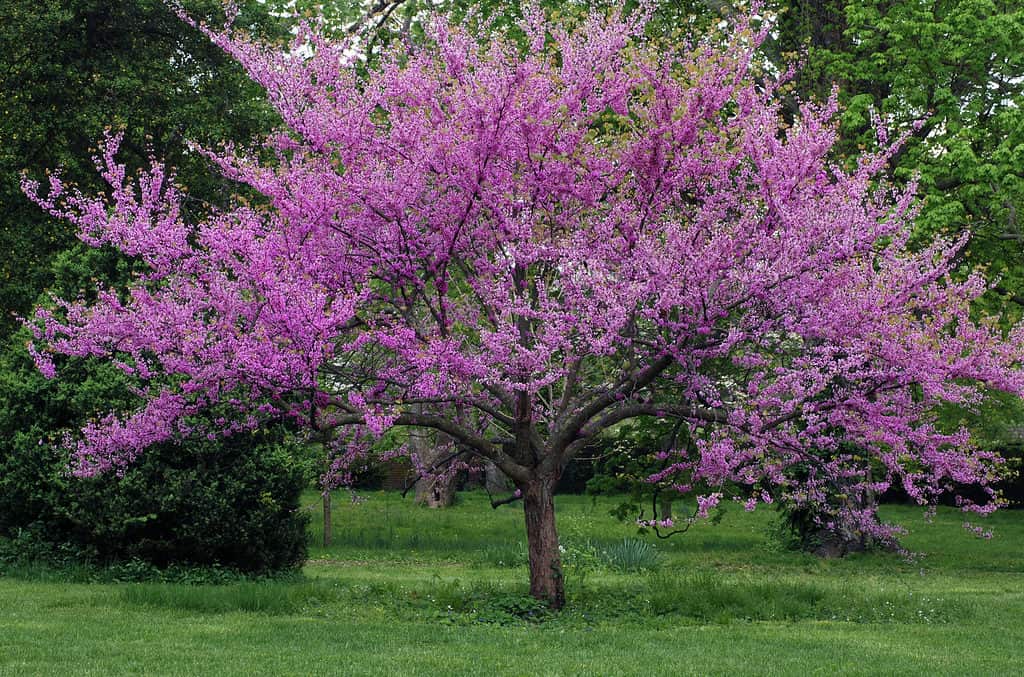
With their lavender-pink flowers and heart-shaped leaves, eastern redbuds are beautiful trees.
©Marie C Fields/Shutterstock.com
Eastern redbuds are fast-growing trees that can add a pop of color to any landscape. The redbud is part of the bean and pea family. While the resemblance may not be quite clear from the flowers, you’ll notice in the summer when the tree begins producing hundreds of bean pods.
Unlike its crop-producing relatives, the eastern redbud’s bean pods aren’t usually consumed. However, people do eat the flowers — raw, fried, or pickled! Usually, redbuds bloom for a few weeks in March or April.
Eastern redbuds grow from zone 4 to 9a, so they’ll really only survive in North Florida. You’ll want to plant them in full sun or partial shade in rich, moist soil. The further south you are, the more shade redbuds will need to survive. It’s best to plant them under some kind of larger coverage in Central and South Florida.
Jacaranda

Jacaranda tree flowers come in a few shades of pink, violet, and purple.
©oxime/iStock via Getty Images
While jacaranda trees aren’t native to Florida, they surely grow like they’re made for the state. That’s because they are indigenous to South America, where the weather is generally warm and humid year-round like Florida. Jacaranda trees produce pink, white, or purple blooms in late spring to early summer.
Jacaranda trees thrive in full sun and sandy soil. Keep in mind that they are deciduous, so take care to plant them in spots that you won’t mind the leaf litter.
Crape Myrtle

The raspberry-colored crape myrtle tree is striking when in full bloom.
©Noel V. Baebler/Shutterstock.com
Crape myrtles come in tons of colors including white, purple, and bright bubblegum pink! The best part about crape myrtles is how easy they are to grow. They are sort of ‘set-it-and-forget-it’ type plants — extremely drought tolerant after becoming established, with very little soil needs.
The one thing crape myrtles need most of all is the sun. While crape myrtles can handle a bit of shade, they bloom best when they’re in full sun. Crape myrtles can survive easily on neglect, but they will certainly become much more showy with regular water and fertilizer.
Silk Floss
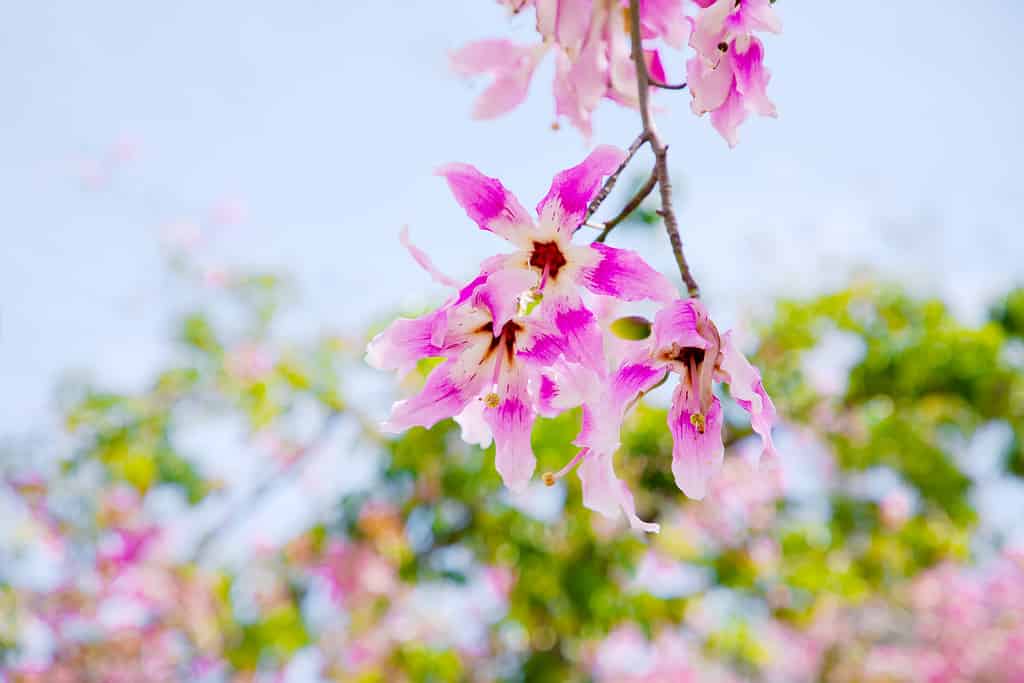
The pink flowers of the silk floss tree are gorgeous.
©Elen Marlen/iStock via Getty Images
Silk floss trees are gorgeous, giant trees that grow in the tropics. They can also survive in Florida, most notably in zones 10 and 11, while a few silk floss trees also grow in 9b. They can’t survive any further north because they do not tolerate any frost. However, the good thing about silk floss trees is that once they’re well established they will be able to survive cooler winter temps.
Something to keep in mind about these trees is that their root systems are extremely large and can lift up sidewalks and roads. Take care to plant it as far from any foundations as possible, and be very aware of your septic tank location as well before planting.
Silk floss trees produce beautiful pink blossoms that fill the entire tree from early winter until early spring. They are very fast growers, putting on 40 inches or more per year, especially in the first few years of life. Something that makes them trees a little different from other trees is their trunks — they’re covered with large, cone-shaped, pointy spikes! You’ll want to plant these trees in full to partial sun and well-draining soil.
Tabebuia (Pink Trumpet Tree)
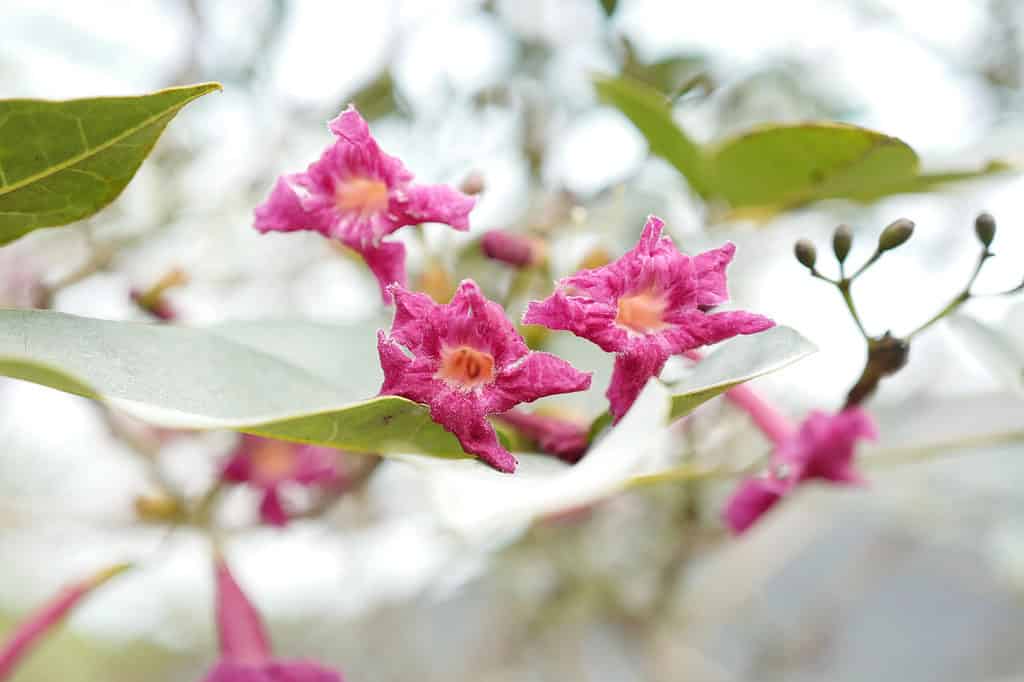
With its vibrant color, the roble cimarron is also called the blood-red trumpet tree.
©Pavaphon Supanantananont/Shutterstock.com
Trumpet trees come in a few colors, including gold, white, and pink! They produce amazing blooms each spring that cover the entire tree. Like many of the other species on our list, Tabebuia trees are deciduous trees that lose their leaves each winter before breaking out into blossoms.
Tabebuia trees can sometimes reach 50 feet tall, but they more commonly grow to 25 or 35 feet. They have a pretty large spread as well, also reaching 25 to 35 feet in width. Tabebuias are native to Central and South America, but they’ve adapted well to Florida’s climate. While they can grow across nearly the entire state, they thrive in the warmer, humid climate of zone 10.
Tabebuia trees do best in full sun and tolerate pretty much any soil type, as long as it is well-draining. The most important thing to remember with these trees is to cover them during any frost or cold temperatures, as they are tropical.
Pink Flowering Dogwood
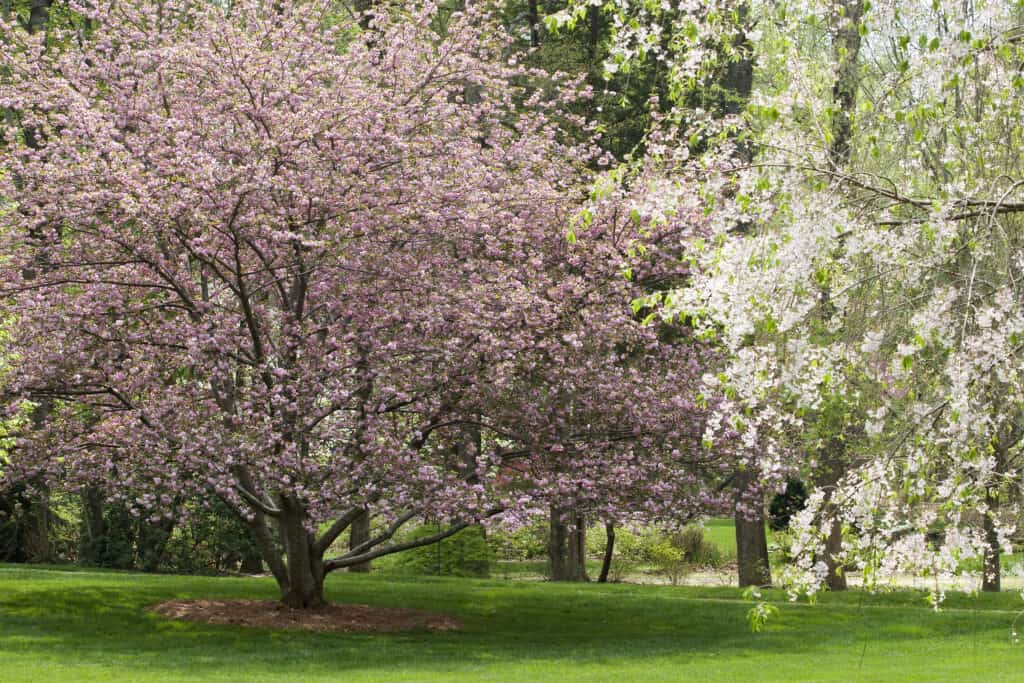
Dogwood trees can flower with blooms that are pink and white.
©iStock.com/JillLang
While most dogwood trees produce white flowers, some species make pink blossoms, specifically the pink flowering dogwood. Their blooms usually grow up to 3-4 inches across, growing directly on the branches of the deciduous trees. They are native to the east coast of the U.S. and Canada.
Pink flowering dogwoods thrive in partial shade and fertile, well-draining soil. They usually grow to around 15 to 30 feet tall and wide. They produce orange-red fruits in the summer which are a favorite of birds and other wildlife.
Knock Out® Rose Tree

With careful pruning, these shrubs can be turned into small trees!
©Jen Wolf/Shutterstock.com
Knock Out® roses were bred by Bill Radler to be drought tolerant, easy to maintain, and to produce blooms nearly year-round. They grow well across all of Florida and are hardier than many other species of roses.
These roses come in many different colors, including red, yellow, and pink. They are incredibly disease-resistant, which is why so many people chose them for their gardens. Despite many of the Knock Out® rose varieties growing as bushes or shrubs, you can also buy varieties that are trees. You’ll want to plant them in full sun for the best blooms. They grow fast and can reach up to 6 feet tall.
Royal Poinciana
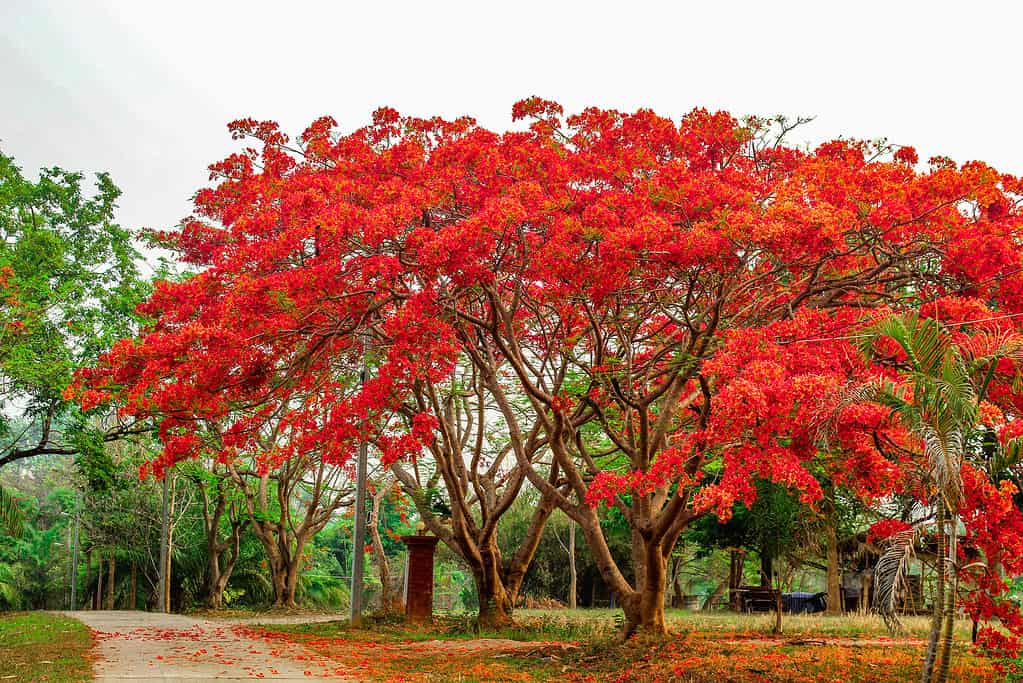
A poinciana tree can have orange, red, or pink-colored flowers.
©Randall W Simpson/Shutterstock.com
Royal poincianas are also called flame trees because of their bright orange-pink hues. They’re native to Madagascar but grow well in zones 9b through 11. While they can survive further north, royal poincianas don’t do well with frost. They flower from anywhere between May and July, keeping their bright blooms for a month or more!
You’ll want to plant royal poincianas in full sun so that they can reach their full flowering potential. They tolerate nearly any type of soil including salty soils, have no major disease or pest issues, and are drought tolerant. Once these trees are established, they’ll grow very large — up to 40 feet tall with a canopy up to 60 feet wide. Like kapok trees, royal poincianas have large root systems that will uproot any nearby foundations. One thing to keep in mind with royal poincianas is that it will take around 5 to 10 years for a newly planted tree to bloom.
Pink Cassia
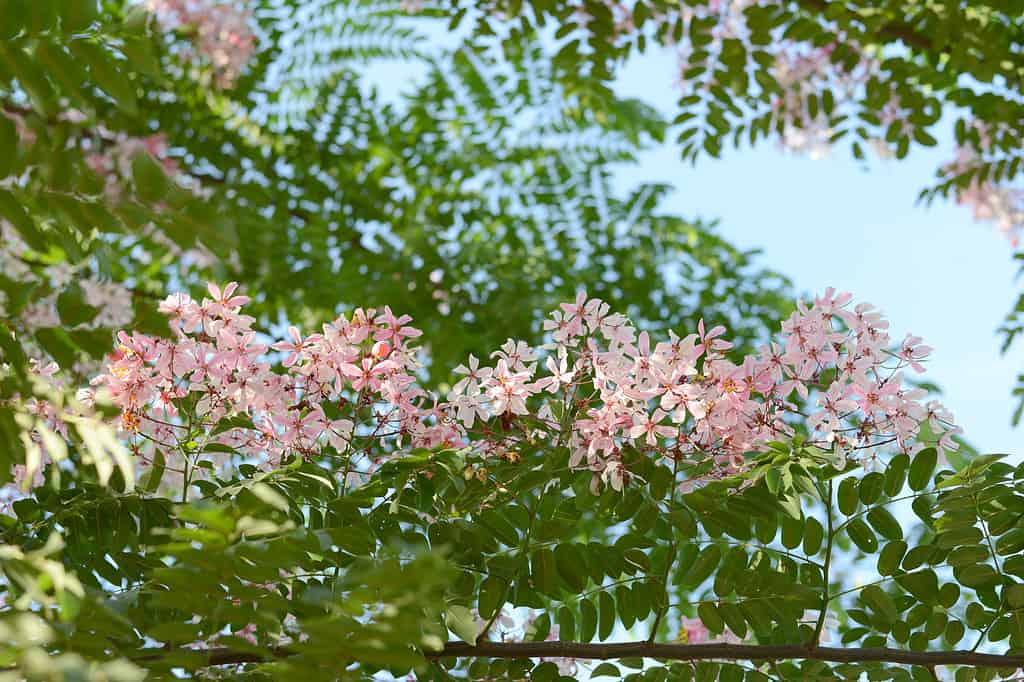
For their showers of blossoms, pink cassias are also called pink and white shower trees.
©Jieophoto/iStock via Getty Images
Pink cassia goes by a few names, from its botanical name Cassia javanica to its common nickname — pink and white shower. It’s called the pink and white shower tree because of its beautiful pink and white blooms. Some people also call it the apple blossom cassia because the flowers are similar to apple blossoms.
Like many others on our list, pink cassias are deciduous trees. They’re native to Southeast Asia and Indonesia. However, they grow pretty well in Florida despite only being introduced around 20 years ago. You’ll want to plant these trees in full sun and well-draining soil.
Silverbell
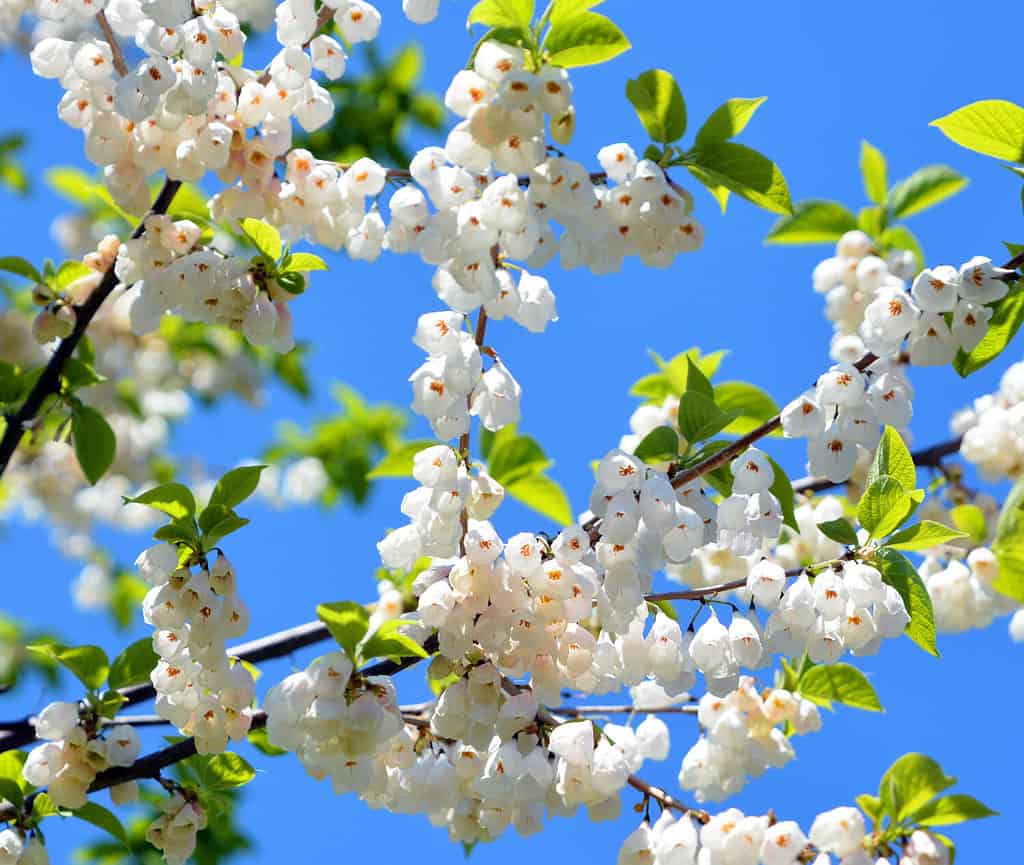
The flowers of silverbells can be white, off-white, and pinkish. Their shape is similar to silver bells, which gives them their name.
©meunierd/Shutterstock.com
Don’t let the name fool you, silverbell trees produce white and pink bell-shaped flowers, not silver! They’re medium-sized trees, reaching around 30 to 40 feet tall and spreading to 20 or 35 feet.
Silverbells grow naturally in North Florida but do well across the entire state once planted. They’re one of the few trees that turn yellow during the Florida fall time. Then, as deciduous trees, they drop all of their leaves in winter before bursting into bloom in spring.
Plant silverbells in partial shade or shade to protect them from the harsh Florida sunlight. They prefer well-draining soil and need regular watering to become established. Silverbells do especially well when planted alongside acid-loving species like azaleas and rhododendrons.
Hibiscus Tree
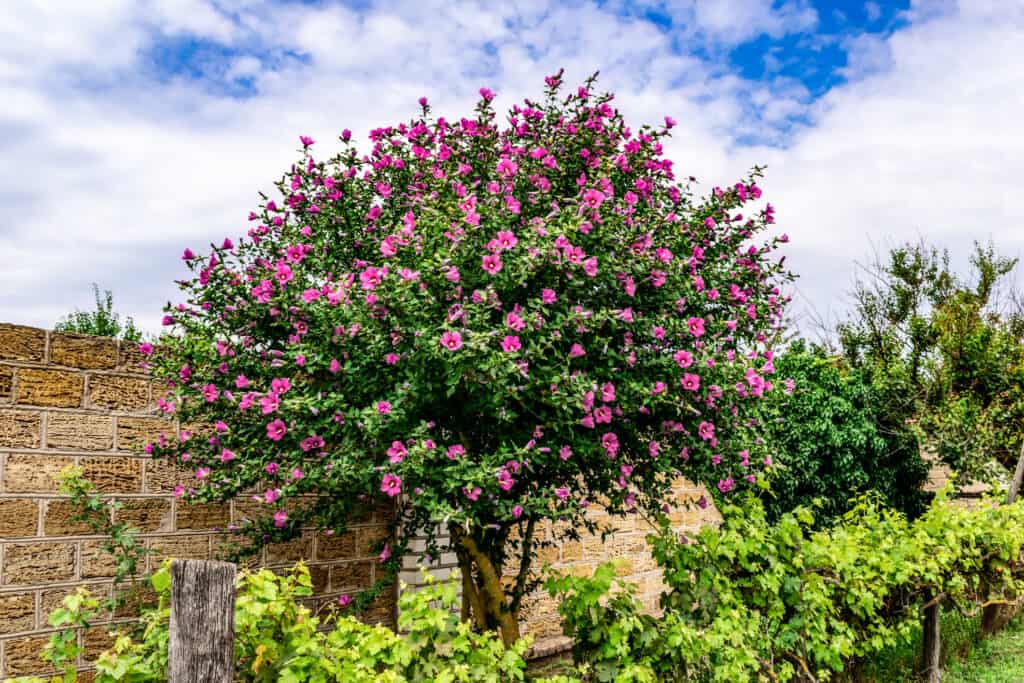
Hibiscus trees are not a common sight, but they sure are a beautiful one!
©iStock.com/ioanna_alexa
Similar to roses, hibiscus plants are small shrubs that have been modified to grow in tree form. Hibiscus trees often have braided trunks that end up growing together and upward up to 20 feet tall. Hibiscus are native to Florida and come in many colors and variations of pinks.
All parts of the hibiscus tree are edible, from their stems to their leaves. However, the flowers are generally the sweetest part of the plant and are most commonly used in culinary crafts. Some people make tea out of hibiscus flowers or leaves. Most people enjoy eating the calyx, which is the leaf-like part of the flower that grows around the bloom to protect it. Hibiscus is one of the few plants on our list, along with their relatives — Rose of Sharon — that are actually edible!
They are sensitive to cold, so after a cold spell their leaves will often turn yellow and fall. The further south in the state they are, the more leaves they will keep. Plant hibiscus trees in full sun to partial shade, in moist soil.
Saucer Magnolia
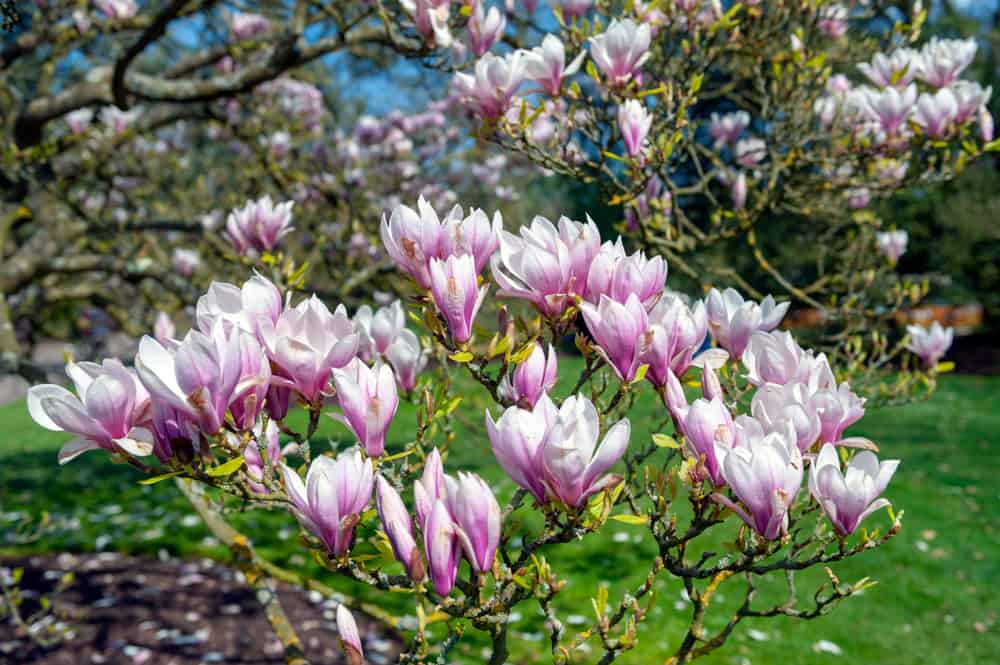
These species (
Magnolia x soulangeana) were commonly called Japanese magnolias, but they are now referred to mainly as saucer magnolias.
©Gaid Kornsilapa/Shutterstock.com
Saucer magnolias produce large, beautiful blooms that can reach up to a foot wide. The petals point upwards, in a similar shape to tulips, and fall slightly as the flower reaches peak maturity.
Saucer magnolias are medium-sized trees that grow up to 30 feet tall with up to 25-foot canopies. They lose their leaves during late fall and regrow them in late spring. They produce pink, yellow, or purple flowers that begin blooming directly on the bare branches just before the new regrowth. The stark contrast of bare branches to flowers is one thing that sets these trees apart from others.
Saucer magnolias grow best in North to North Central Florida and other cooler parts of the U.S. They do well in zones 4-9a. Saucer magnolias are pretty easy to maintain once they are established, but they require regular watering for the first year or so. You’ll want to plant them in full sun to partial shade, in fertile, well-draining soil.
Azalea

Azaleas can grow as trees in the garden or as bonsai trees in pots on porches.
©irinacapel/Shutterstock.com
While azaleas generally grow as shrubs, with careful pruning and training, they can be shaped into trees. Azalea trees look similar to hibiscus trees in the fact that they have braided trunks. Azaleas are not extremely toxic, but they can be very dangerous if ingested by humans or animals.
Most notably, azaleas have been the culprit of ‘mad honey’ poisonings. Bees in areas with a high population of azaleas will produce honey that contains some of the plant’s compounds. Ingesting the honey causes confusion, irregular heart rate, and low blood pressure. While accidental ingestions of plant matter can be dangerous, they usually aren’t life-threatening unless large amounts are consumed.
As long as you are aware of the risks that come with azaleas, feel free to plant them anywhere in gardens or pots. They grow best in North and Central Florida, hardy up to zone 9. The trees prefer acidic soil and filtered shade.
Oleander
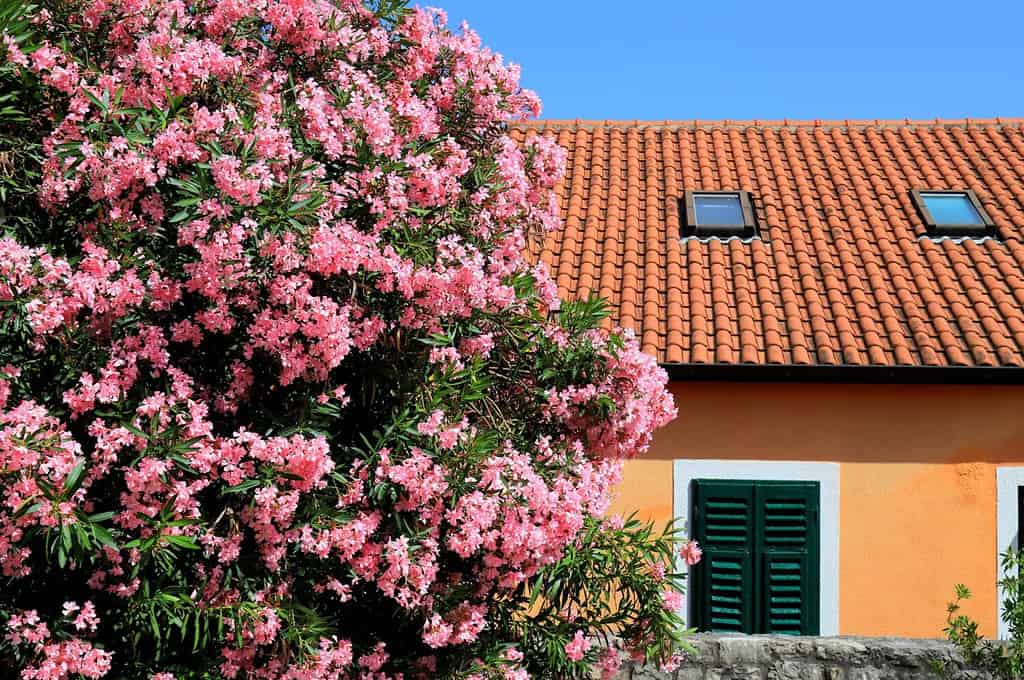
While oleander trees are beautiful and easy to grow, they’re also highly toxic. Take care to plant these flowering trees far from kids and pets.
©rospoint/Shutterstock.com
Oleander trees are native to Africa and the Mediterranean, but they’ve adapted extremely well to Florida’s similar climate. They’re incredibly hardy and fast-growing, reaching 18 feet tall with proper pruning and training. To encourage them to continue growing in tree form, you’ll want to remove suckers that grow at the base.
Oleander trees are notorious for their toxicity. Every part of it is toxic if ingested, from the flowers to the roots, so it’s important to keep these trees away from curious pets and small children.
Oleander grows best in warmer places, including zones 9a through 11. It will take frost damage if planted in North Florida, but it’s pretty hard to kill. Oleanders are drought-tolerant, salt-tolerant, and capable of growing in very poor soil. They do best in full sun but can also survive in partial shade.
Did you realize there are so many beautiful pink flowering trees that grow all across Florida? If you’re interested in learning about even more flowering trees in Florida, take a look at this article next!
Pink Flowering Trees in Florida
| # | Tree | Where To Plant |
|---|---|---|
| 1 | Eastern Redbud | Partial shade and rich, moist soil. |
| 2 | Jacaranda | Full sun and sandy soil. |
| 3 | Crape Myrtle | Full sun |
| 4 | Silk Floss | Full to partial sun and well-draining soil. |
| 5 | Tabebuia | Full sun and well-draining soil. |
| 6 | Pink Flowering Dogwood | Partial shade and fertile, well-draining soil. |
| 7 | Knock Out Rose Tree | Full sun. |
| 8 | Royal Poinciana | Full sun. |
| 9 | Pink Cassia | Full sun and well-draining soil. |
| 10 | Silverbell | Partial shade to shade and well-draining soil. |
| 11 | Hibiscus Tree | Full sun to partial shade in moist soil. |
| 12 | Saucer Magnolias | Full sun to partial shade in fertile, well-draining soil. |
| 13 | Azalea | Filtered shade and acidic soil. |
| 14 | Oleander | Full sun. |
The photo featured at the top of this post is © Rinelle/Shutterstock.com
Thank you for reading! Have some feedback for us? Contact the AZ Animals editorial team.







